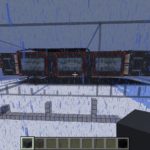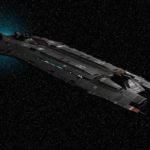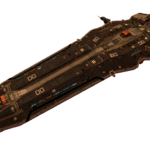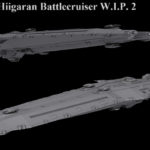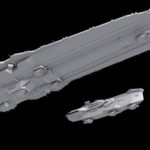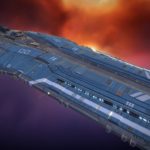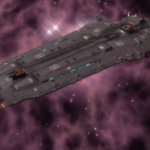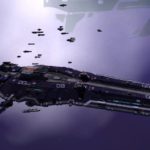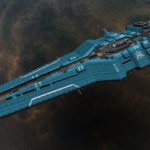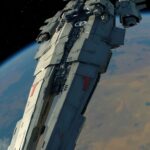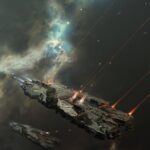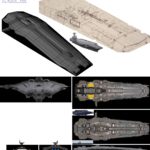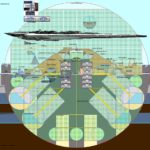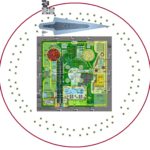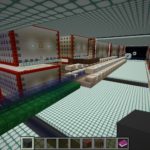This is the Spacecraft-carrier the Inisfreeans (ICVs) made and sent to 34 Tauri for a social experiment / checkup.
–
Table of Contents:
- Introduction
- Etymology
- Capacity
- Decks & Sections
- Forces Allocation
- Positions Aboard the Carrier
- Compared to New York City in 2010
- Additional Facts / Dress Code
- Deployment History, Schematics, & More
- Close Encounters of the 3rd Kind
- Form, Layout, & Appearance (Images Begin)
- Comparisons
- 2022 Update: Minecraft Scale-model
- 2023 Updates (numerous sub-sections)
- 2024 May/+
–
Introduction:
This ship is a Space-faring aircraft-carrier designed & manufactured by the Inisfreeans (for a project in the 26th century), tested out near the Sun‘s Oort Cloud, and deployed to the 34 Tauri solar-system as a social experiment to see to what extent some of the humans, who migrated to and colonized the worlds of that system, can & will now coexist peacefully with the Inisfreeans. Prior to that migration, humanity’s minds had become nearly vestigial, and their reactions defaulted to the negative, void of logic or critical thinking. If they have since evolved to think & behave much better, the Inisfreeans will no longer keep such a close watch on them.
* Its predecessors were the flying ships of Sotu called Rooftop Carriers.
2023 August reiteration: The purpose of this carrier is not to provide large-ship or main-military support to the UAP, but to reach each 34 Tauri world which has potentially now-somewhat-compatible humans living and/or working on it. While it is traveling that route, it encourages the main organization of 34 Tauri; the UAP, to use it as a mobile base for joint operations; it can assist them with whatever they need, so long as they respect that its unflinching/non-negotiable purpose is to be a social experiment, not a vessel they can move around as they please, and not a vessel that can always respond to distress calls. The Inisfreeans want to help the people of 34 Tauri do what they need to do, so long as that help from the Inisfreeans comes in the form of whatever can continue contributing to the data-collecting of this social experiment of theirs.
–
Etymology:
‘The New Horizon’ (TNH) name is due to:
- this Spaceship patrolling throughout a region of Space with many worlds, thus resulting in frequent literal new horizons as it enters and exits their orbits,
- and because this social experiment is the long-anticipated social-interaction and human-development ‘new horizon’.
- ‘The New Horizon’ was also once the name of the original form of this website you are navigating today.
–
Capacity:
The maximum legal/recommended capacity of this Spacecraft-carrier is ~64,000 human-sized people. This is dependent upon the actual family members brought to live aboard; their dimensions, possessions, etc.. It may be possible to reasonably squeeze in a few hundred more, given the right conditions (such as when people prefer to share quarters (of berths; bunks) and restrooms, etc., versus individuals who are accustomed to a little more privacy for work and leisure).
Decks and Sections:
TNH has the following 16 major sections/divisions. Its thousands of crew members are highly-trained specialists who stick to work in just one of the following sections/divisions. That means there are several hundred crew members, on average, for/in each of them.
- E.M Bumpers: the opposite of a tractor-beam, but not quite a full energy-shield
- Singularity Redirectors: sophisticated devices capable of using micro-black-holes instead of crude deflection
- Smart-Tissue Biomechanical Nanofibers: TNH’s structure can flex, deflect, absorb, communicate, regrow, and more
- Crypto/Fill Chamber: where the encryption programs for field radios and other devices are kept and updated
- Photonic and Quantum Transmissions: the signals traffic center (for regular and non-stop communications) for the whole ship
- Quantum Teleconference Chamber: radio, microwave, and hyper-space communications are no longer needed
- Chaffs: strips of metal foil or metal filings released in the atmosphere from aircraft, or deployed as missiles, to obstruct radar detection or confuse radar-tracking missiles
- Electronic: ‘noise’-based jamming aimed at RADAR antennae/dishes (and Electric/Electronic Counter-Measures (ECM) triangulation devices; based on what jamming/’noise’ is being experienced, and which areas are not showing normal/clear RADAR images/volumes (3D-space), especially when TNH with escort/support ships, or its own Space-fighters are deployed, the source and type of ECM of the enemy can often be determined, something like plotting the trajectory of ‘dead zones’ / ‘blank spots’)
- Electromagnetic & Ionic: energy bursts used for jamming, similar to HAARP technology
- Flares: a device producing a bright flame, used especially as a signal or marker, in this case ones which ‘burn’ even in Space, diverting some types of missiles
- Gamma Rays: energy bursts for causing radiation damage, such as on the cellular and genetic level to hostile biomechanical vessels
- Microwave: energy beams for causing heating in a way capable of bypassing layers such as armor
- RADAR / LIDAR: for range-finding and general-detection based on local atmosphere (LIDAR for Space)
- Quantum: a new type of phase-shifting counter-measure which can appear only at the most opportune moments
- Singularity : black-hole torpedoes and debris-less self-destruct
- Aquaponic Grow Modules: FreightFarms taken to the next level; all needed food is grown aboard this ship
- Mess Halls: where everyone eats
2023 August update: These are also where the subset-rooms are which handle the packing/sealing of food and drinks into Space-worthy MRE-equivalent rations.
Aquaponics are used, but the fish are not consumed, and much of the needed food is supplied from allied worlds/facilities each time TNH nears/orbits them.
- Cryogenic Archive: cold-storage when true-stasis is not an option
- Ejection Modules: ‘life-boats’
- Safe Rooms: when life-boats are not an option
- Singularity Cancellation Module: a clever way around black-hole issues
*To prevent pedestrian congestion (foot-traffic jams) toward those closest locations of these boats/pods, ICVs make sure they are directing everyone in the most-efficient way; the nearest ICV will always alert and guide the human TNH passengers/crewmates within hearing-range / arm’s-reach of her, their (the ICVs’) shared-consciousness ensuring only 3 of those people head to each vacant/unclaimed pod, and 4-12 (based on how many bags they are trying to bring with them) head to each vacant/unclaimed lifeboat.
- A.I. Core: the supercomputer ‘brain’ of the whole ship (using quantum computing & quantum code-breaking for exponentially faster calculations)
- Bridge / Flag Bridge: the two-tiered helm room
- Combat Information/Data Center (CIC/CDC): the backup Bridge, more or less
- Forecastle (Focsle): where the anchors are
- Map / Briefing Omni-max: the dome-ceiling auditorium with both projector and hologram-based display controls
A combo of lasers, weight sensors, and special cameras help police-call spot any floor debris.
- Large Hangars: for Dropships (DS) (multiple stories tall) (* Auz‘s Firefly-class transport-ship “Persephone” is stored in one of these hangars)
- Intermediate Hangars: for (1-to-2 story) Escort Vessels, Shuttles, and the Spacecraft of visitors, plus the occasional Fighter-craft
- Small Hangars: for Drones, Small/Mini Shuttles, & POVs (Personally-Owned Vehicles; single-story tall Spacecraft, in this case)
- Single-craft Hangars: for Fighter-crafts; 1 ‘jet’ per
- ODST Drop-Bay: where the modern Army Airborne (now “Spaceborne” in the 2500s, A.D.) deploy from
All ships escorting TNH, and all ships/fighters/mechs/POVs docked in it, are human-made (non-invincible) ones.
Tractor beams can recall pods dropped if the mission is aborted while they are still in range of the beams.
ICVs don’t need/use drop-pods or ejection-pods; they just go naked out any hatch or airlock, if needed outside.
- Engineering: life support, propulsion array control, etc.
- HAZMAT: a Hazardous Materials ward for the quarantining of cargo, rather than personnel
- Laundry: all uniforms and other clothes are cleaned in these modules
- Lifts: mag-lev and repulsine-assisted service elevators capable of moving dozens of tons (such as Fighter-craft), similar in nature to a stationary or track-restricted TR-3B
- Waste Management and Recycling Modules: where the fecal matter, trash, etc. go
Recycling in TNH is not of everything (subatomic transmutation), as we did not allow our highest levels of tech’ to be part of this ship, thus TNH can recycle what Outlanders are used to recycling, which includes cardboard, metal, plastic, etc..
Trash still exists and must be shipped out; that’s whatever this limited-tech’ vessel was not designed to be able to reuse.
Maintenance sailors in TNH constantly monitor the numerous air filters devoted to every hangar, hall, and most other rooms, and change their charcoal filters and other components as needed, often in advanced of any clogs or expiration dates.
ICVs handle most janitorial work.
- Medbay/’Sickbay’: where everyone goes to heal
- Quarantine Wing: where personnel returning from contaminated places (planet-side or in derelict ships, etc.) go until proven healthy & clean
- Commercial Area: our mobile PX (Post Exchange; like Wal-Mart for military bases with families)
- Community Lounge(s): where personnel still aboard go for R&R
- Gymnasium(s): with ‘machines’ and sections for CFT/CRT, CrossFit, Gymnastics, Le Parkour, etc.
- Martial Arts Dojo(s): with inventory and sections for Jeet Kune Do, Krav Maga, Ninjutsu, Sayoc Kali, etc.
- Observatories: where personnel go to stargaze (or planet-gaze)
Mail is allowed, and is scanned for harmful contents where it is received at planet-side post-offices, then before it is loaded onto a military transport craft, and when it is received in a TNH hangar or a waypoint-facility.
Cargo-crewmates get mail into TNH, but do not deliver it to ships docked in TNH.
The vast majority of mail is digital, not envelopes or packages. Typically the only packages allowed into TNH are those containing supplies for its personnel’s authorized operations; missions, resupplying the mess halls, restocking Commercial Area/Wing shelves, etc..
- Power Plant / Reactor Room: cold-fusion based, but not quite scalar (zero-point; the energy of the void; using Space itself as the fuel/power-source)
- Fuel Cells Chamber: Thorium Containment (the reactor is advanced and efficient, but still depletes from time to time)
- E.M. Thrusters: Repulsine-based accelerators (sub-light drives)
- Fusion Concussion Boosters: using controlled nuclear detonations as accelerators
- Gravity Slingshot Calculator: when it’s time to ‘run silent’ (not even impulse-power)
- E.M. Catapults: for stowed/docked/ejecting crafts (TNH’s version of an ocean-carrier’s fighter-jet runway-launch hook-&-cables)
- Admirals’ Wing: for the TNH commander’s staff officers and distinguished guests
- Captain’s Wing: for the commanding officers of any escort vessels
- Officers’ Section: for all the other officers; the company-grade officers (not Admirals or Captains)
- Enlistedmen’s Section: for all non-commissioned personnel
- Families Section: for the spouses and children of some of the officers and enlisted
- Contractors’ Section: for all non-military personnel
- Companions’ Section: for all Registered Companions on active-duty with the fleet
- Quarters & Berths: lodging and sleeping arrangements for all of the above
2023 August update: Each of those living-quarters sections of TNH are where ICVs handle to collection and packaging/sealing of all the cum that Nyria might ever want/order; there is no central location for this, though it does/can get palletized in the CIF.
ICVs on duty in the brig set their hair and eyes to gray/silvery.
- Brig: military prison
- Dispatch Office: military police
- NCIS Office: military detectives
- IS/IT Office: military computer-security technicians
ICVs on duty as assistants to the carrier’s military police set their hair colors to red and blue at the same time (different strands/locks, alternating), and their eyes colors to slowly shift from bright (not light/pale) blue to red (transitioning back and forth)
- Central Issuing Facility (CIF): supply & gear distribution
2023 August update: This is also where the subset-room is which handles gear repairs (such as patching up astronaut suits).
- Ammunition Wells: for the spectrum cannon batteries, and kinetic-impact rod-bays
- Armories: for the ‘small arms’; man-portable & crew-served weapons for personnel & small/terrestrial vehicles
- Spectrum Cannons: including MASER, Ion, ‘Port’er (opening a portal inside the barrel in order to fire through a worm-hole rather than pure-linearly), and Cyclers (guns which change the type of energy beam they are firing as rapidly as a machine-gun fires bullets; a way to overwhelm certain energy-shields)
Though Inisfreeans passively assist with the tasking each of those sections has, they usually leave it up to the human crew-members to work through (at least unless/until requested to join in). On Inisfreean ships, all of those things are done automatically by the ships themselves, each of them being an intelligent being. TNH needed to be more like a traditional human aircraft-carrier, though; it needed to be the kind of (star)ship humans would understand how to navigate, operate, and live within.
Forces Allocation:
TNH has thousands of personnel stationed aboard it at any given time. Most are active-duty military, with the smaller categories of people aboard being 1) Inisfreean personnel, 2) family-members of active-duty humans, 3) civilian contractors, 4) guests/visitors, and 5) other (occasional evacuees, refugees, etc.). The following are the totals of each major division of TNH’s forces:
Quick Reference/Tallies:
Family Members: (thousands; exact number kept classified)
Shipboard Civilian Contractors: 2,000
Registered Companions: (thousands; exact number kept classified)
Inisfreeans: (thousands; exact number kept classified)
DS Complement:
LAR Complement:
Those DSs are considered “small” only in comparison to the town-sized ones used by Inisfreeans and others; some of those other DSs carry gigantic skyscraper-sized BattleMechs, hundreds of vehicles, and thousands of troops. The DSs here in TNH are like slightly-larger and Space-faring versions of military cargo-planes.
–
Forces Allocation Specifics:
Everyone aboard TNH, who is part of its crew, is grouped into the following three categories: 1) Total Complement (everyone, whether they stay aboard TNH or deploy from it), 2) The Wing (those who deploy to protect and escort smaller Spacecraft), and 3) the Mobile FOBs (those who deploy to ferry personnel, vehicles, and supplies to and from planets and other areas of operation).
Total Complement: ~32,000
Active Duty Military: ~10,000
Civilian Contractors: ~2,000
Companions & Inisfreeans: ~20,000 (with the Inisfreeans being the vast majority here)
* No clones (of TNH’s original, pre-34-Tauri crew) have families, and half of TNH crew is of this category.
–
The Wing: 118
There are 118 personnel aboard TNH who are members of its fighter-jet unit. This unit is known as “The Wing”, and it is often split into a duty-rotation ensuring some of its pilots are always on patrol around TNH, while others are on-call / standby, with the remainder asleep/recovering. Unmanned Aerial Vehicles (UAVs, a.k.a. “drones”) are also available to assist with these roles, but TNH always involves its human teammates.
- Fighter Detachment: 105 (13 officers, 105 squadron members (including commanders))
- Interceptor / Fightercraft: 5 squadrons of 21, single pilot; no co-pilot or navigator
Though only ~100 TNH personnel are part of The Wing, thousands more support them; those who stay aboard TNH are the ones who inspect and service their fighter-craft, unloading and reloading them with armaments, decontaminating them and running diagnostics, etc.
–
The Mobile-FOBs:
Dropships (DSs) are sometimes called “mobile Forward-Operating Bases” (FOBs). There are 30 human-configured DSs contained in TNH’s large hangars. Each of those DSs is capable of carrying, deploying, and retrieving dozens of personnel with multiple land-based vehicles.
- DSs Detachment: 29 (12 officers, 17 DS officers)
- DSs Complement: 94
- * Each DS contains 15 crewmen, 2 Thor pilots, 5 LAR Vs (35 Marines total; in each LAV), and 1 Seabees platoon (42 Seabees). 1 LAR-V Complement is 3 crewmen and 4 scout infantrymen (7 total).
With 30 of these “mobile FOBs”, that means ~3,000+ of TNH’s total complement is devoted to operating these Spacecraft and the vehicles they contain.
–
Deck/Department-specific Numbers:
Flag Officers and H&S:
Commanding Officer (CO): 1
Executive Officer (XO): 1
Command Staff: 10 (the S-1 senior officer, S-2, S-3, S-4, S-5, etc. –further details here)
Departments:
The following bullet-notes start with the estimated number of needed personnel per shift in each, followed by total (officers and enlisted).
- Communications: 40 ~120 total?
- Navigation: 40 ~120 total?
- Combat Data/Information Center: 53 ~109 total?
- Legal: 27 ~81 total?
- Religious Services: 27 ~81 total?
- Intelligence: ~55+ ~165 total?
- Medical: ~54+ ~1,409 total?*
- Science:~42+ ~126 total?
- Engineering: ~54+ ~1,409 total?*
- Mechanical: ~54+ ~1,409 total?*
- Signal: 40 ~120 total?
- Air Traffic Control: 53 (348 total)
- Fighter-jets Detachment/Wing: 105
- Marine Detachment: ~1,200 (including the Dropships Detachment)
- Security: ~54+ ~1,409 total?* (always ~470 available, ~10 in dispatch, ~30 in brig, ~430 on patrol)
- Cannons: 53 ~159 total?
- ODST Detachment: ~16 (like ~1 SEAL platoon of ETW)
- Armory: 41 ~123 total?
- Ordnance: 53 ~1,409 total?*
- Central Issuing Facility (Supply): 27 ~81 total?
- Finance: 27 ~81 total?
- Deck (Hangars + Halls): 53 (1,314 total)
- Hazardous Materials: 40 ~120 total?
- Forecastle (Anchors + Tractor-beams): 27 ~81 total?
- Food Services (Chow Halls): ~53+ ~1,409 total?*
- Morale, Welfare, Recreation*: 27 ~ total? (not doing bartending or waitressing, but managing the managers of the fun rooms)
- Safety: 53 ~159 total?
- Companions: ~4,000
- Training: 53 ~159 total?
- Contractors: ~2,000
Sol Protection Administration Liaison: 1
Other Liaisons: (varies; based on “float” and mission/s)
*ATC-personnel Calculation:
- 8 external towers x 3 per (24)
+ 6 lg (large hangars) x (7/tower & 42 floor) (294)
+ 12 md x (3/tower & 12 floor) (180)
+ 14 sm x (1/tower & 3 floor) (56) - = 554 ATC+Deck on duty at any given time, thus this combo of dept’s has ~1,500, making it one of the biggest portions of the crew
- (116 ATC on duty, and 438 Deck on duty, thus ~348 in ATC and ~1,314 in Deck)
*Commercial Wing is mostly/all ICVs and contractors, as are the lounges. It is not staffed by MWR sailors/personnel, but some of the people they help manage/oversee.
–
Companions Allotment:
Total Companions: ~2,000
Minimum: 16 (one for each TNH department/section)
Maximum: 2,333
All are Registered (Outlander) Companions contracted to work aboard; they are stationed here.
Companions are not needed for:
- TNH-native clones crew (~5,000 personnel; ICVs)
- married human crew-members opting for monogamy (~2,500)
- spouses and children (~21,000)
Crew-members needing Companion services: ~3,500
- singles (enlisted and officers)
- polyamorous couples
- those interested in learning about a possible career as a Companion
Companions needed for potential:
- dignitaries (~100)
- other VIPs (~100)
- evacuees (~16,000)
Companion Workload Breakdown:
- Float duration: 1 Earth-year
- Shipboard people needing Companion services: ~3,500 to 19,500
- Clients per month: ~291 to 1,625 (28 day period)
- Clients per day: ~11 to 58 (16 working hours per day)
- Clients per hour: ~1 to 4 (at any given time during deployments, with zero-to-maximum-allowable visitor capacity)
- The usual Companion visit is at least 4 hours, because: [(1-to-4/hr) x 4 = 4-to-16 clients/each 4-hr period] 16 Companions on duty at any given time.
Standard Constant Crew Division:
- Asleep / Off-duty: 1/3 of total (~4,000)
- On Standby: 1/3 of total (~4,000)
- Working / On-duty: 1/3 of total (~4,000)
- ‘Available’ Crew: ~2,500
- ‘Available’ Contractors: ~2,000
- Total ‘Available’ Shipboard Personnel: ~4,500 to 7,000
Projected Average Companion Client-base:
- ~1,500 to 2,333 (who may call on Companion services at any given time)
- 1,500 suggests 6,000 people aboard (crew members, plus family members, visitors, etc.) interested in Companion services within the same time-period/s; 1,500 on duty, 1,500 at rest, 1,500 on Quick-Reaction Force (QRF) duty, and 1,500 patrolling/servicing their parts of TNH
- 2,333 suggests 9,332 people aboard (crew members, plus family members, visitors, etc.) interested in Companion services within the same time-period/s; 2,333 on duty, 2,333 at rest, 2,333 on Quick-Reaction Force (QRF) duty, and 2,333 patrolling/servicing their parts of TNH
Companion services don’t always mean sex; they can be therapeutic, as in counseling or massage. Companions are also often available to help traumatized crew members fall asleep; they snuggle, offer sleepovers, etc. Companions are here for the times when mothers, wives, or girlfriends cannot be.
–
For Families:
There are often families housed aboard this ship, as TNH is half-human/military and half-Inisfreean/paradise. Families are unable to access the work-stations/decks of their service-member family-members (such as the Bridge, hangars, etc.). They instead are free to roam the declassified, safer areas of the ship.
- Teachers: ~900 (for ~14,000 children)
- Employers: ~200
- Transportation Management: ~1,000 (for the ‘mag-lev’ trains; dozens of trains’ driving, repair, and monitoring needs)
- * The remaining ~2,125 support personnel aboard TNH fall into its various departments.
–
Totals Update:
Crew:
- Military: ~10,000 (~half are female; 5,000)
- Contractors: ~2,000 (~half are female; 1,000)
- Companions: now ~4,000 (not the original 2,000 estimate –and all are female)
- Inisfreeans: 16,000 (“half of TNH’s crew is the pre-34-Tauri clones”)
*There are 16 of each of the 1,000 face/body-types of ICVs, ~1 per department. - Total: ~32,000 (~26,000 are female)
Non-crew:
- Spouses: ~9,000 (some are in non-monogamous marriages; multiples wives per military husband, or multiple husbands per military wife, etc.)
(~half are female; 4,500) - Children: ~12,000 (~1.2 children per couple/triad/family working aboard TNH)
(~half are female; 6,000)
GRAND TOTAL: ~57,000 (~36,500 are female)
*There are no kajirae aboard TNH, as its role is to see how 34 Tauri humans interact with me and ICVs, not with kajirae.
Humans working aboard TNH must be fit, have no distended abdomens, and be what Auz would consider normal-looking; they cannot be deformed or ugly in any way, as was/is the case with most sailors and all other members of the failed human species before/elsewhere.
At least 1 person from every world with people on it; that was the “rule of thumb” / aim. Worlds with no UAP presence then are scouted for useful contractors (as opposed to service-members; military). The goal is to always have a full representation of the populations/cultures of 34 Tauri, thereby seeing how humans from all those places react to ICVs.
Positions Aboard this Carrier:
All of the above-mentioned jobs and departments aboard the USS TNH are organized here in its Jobs Chart. Jobs are also known as “billets” or “positions”. TNH has thousands of them, and many of them sometimes need to be filled / re-staffed during deployments (due to injuries, service-contract completions, special assignments/changes, etc.).
–
Noteworthy Personnel:
The following TNH personnel are those who are the most-often involved in major TNH missions and related activities. Often, this means they are considered “senior” in terms of time-in-service, time-in-(pay)grade, and time spent out on deployments/missions. You’ll also see them mentioned many times in the 8th novel of the Capital of Antarctica series.
Name, Rank, MOS, Assignment:
- Alexia – Civilian / SPA Agent / Internal Affairs Assistant
- Colbert, Adolf – CAPT / Commanding Officer
- Collins, Mackenzie – LT / 02XX / Intelligence Officer
- Demidova, Mica – LCDR / 02XX / Chief Intelligence Officer
- Djinn, Tethir – Civilian / Medical Contractor / Adviser
- Junipher, Bailey – Companion / 69XX / Companion
- Mariya, Zhanna – CPO / 0326 / ODST
- Masters, Glen – CWO4 / 35XX / Chief Mechanic
- McNamara, Dallas – CWO4 / 30XX / Chief Armorer
- Nassida, Vince – LT / 58XX / Security Chief
- Sawatari, Dan – CWO4 / 13XX / Chief Engineer
–
For more forces-allocation specifics (exact roster numbers for each section, department, and team), please see Jobs Chart webpage above, or inquire within.
Compared to New York City in 2010:
NYC Dimensions:
New York City in 2010 (NYC 2010) had a population density of: 27,532 residents per square-mile; 27,532/mi^2 (so ~13,766 would be in half that area (including vertical office- and living-space)). NYC 2010 spanned ~300 square-miles, and had a population of ~8.2 million people (residents); 8,200,000 divided across 300 square-miles = ~27,333/mi^2. That results in each person supposedly having ~1,000 square-feet of space for his/herself, and the only reason the streets remain congested is because 90% (or more) of NYC 2010’s space/area was taken up by big skyscraper “footprints”, forcing all those people to cram into cars, lanes, lobbies, stairwells, and elevator shafts.
NYC 2010 had ~6,000 high-rise buildings (more than 7 stories), ~270 of which were classified as skyscrapers (more than 40 stories); that dramatically increases the room its residents and guests have to move around in (adding tens of thousands to hundreds of thousands of building-sized floors or levels to the equation). More specifically, NYC 2010’s area (~300 square-miles) then becomes a volume (not just an area; 3D, not 2D), allowing for more dispersion (at least of the wealthier residents and guests). Now here’s the big difference between NYC 2010 and TNH; the high-rise buildings and skyscrapers of NYC 2010 are all spread apart many yards/feet, because they have multi-lane streets between them, while TNH is like a fully-touching grid of high-rise buildings and skyscrapers, all the streets that connect them contained within.
* There were ~1,000,000 buildings in NYC 2010. With only ~6,000 being high-rise (~.6%) and ~270 being skyscrapers (~.027%), that doesn’t increase NYC 2010’s habitable area much into a significantly-different volume, but it still creates a lot of extra space for people. To keep things simple, we’ll use the math that: 1 high-rise = at least 7x the space of a normal building, and 1 skyscraper = at least 40x the space of a normal building; [1,000,000 buildings + (6,000 x 8) + (270 x 41)] = [1,000,000 + 48,000 + 11,070] = 1,059,070 normal (single-story) buildings’ worth of space.
TNH Dimensions:
Measuring ~4,000′ by ~2,000′ by ~500′, TNH has a “footprint”/shadow of ~8,000,000 square-feet (or ~.3 square-miles) and a volume of ~4,000,000,000 cubic-feet (or ~.027 cubic-miles). For simplicity’s sake, we’ll round that to be a “footprint” of ~1/3 of a square-mile, and a volume of ~1/36 of a cubic-mile. That makes TNH ~1,000x less spacious (spread out) than NYC 2010, and perhaps ~1,050x less voluminous.
- Length (Depth): ~4/5 of a mile; ~4,000′ (~8x the height)
- Width: ~2/5 of a mile ~2,000′ (~4x the height)
- Height: ~1/10 of a mile; ~500′ (50 decks; floors; levels; stories –twice as tall as aircraft-carriers on Earth)
In that space/volume, TNH may harbor up to 32,000 guests, again: for a maximum capacity of 64,000 people (32,000 crew + 32,000 passengers).
NYC-to-TNH Dispersion Comparison:
Compared to NYC 2010’s per-mi^2 population-dispersion (~27,333/mi^2), TNH has almost the same number contained in its .3-mi^2 (1/3 of a square-mile) “footprint” (32,000 vs. 27,333). This does not result in crowding and congested passageways within TNH, though; unlike NYC 2010, 100% of TNH’s volume is skyscraper-tall fully-connected sections. In other words, TNH’s .3-mi^2 “footprint” is, on average, 40 to 50 stories tall, making it more like how spacious 15 square-miles of NYC 2010 would be.
Additional Facts:
Dress Code:
With humans, Inisfreeans, and the occasional non-human alien aboard this vast ship, and with an entire shopping mall built right in, one can expect to find a wide variety of fashions. Here is what each demographic aboard the U.S.S. T.N.H. most often wears:
- Human Crew Members: normal, fitted, military uniforms & astronaut suits (see below for a sub-section with more specifics)
- Inisfreean Crew Members: their revealing & suggestive Inisfreean uniforms, bellies and under-boobs always exposed, or nothing at all (TNH is, after all, a social experiment to see which of the modern humans are comfortable with the Inisfreean people & Way)
- Registered Companions: kimono-like silk robes (or couture evening gowns) with nothing underneath, footwear usually limited to fine sandals, never high-heels
Uniform Types:
- Base/basic = the fatigues/utilities and service/Dress (2 different) uniforms of the UAP
- Over-wear = color-coded astronaut suits; red, etc., for hangar work, and non-color-coded for flight crews, passengers, contractors, etc. (see below section for all details)
- Dress Blacks for ICVs other than Nyria
- Dress Rainbows for Nyria
–
TNH houses (contains/shelters/transports):
(in order of size, descending; largest to smallest)
- (in the large hangars) Dropships (~50′ tall)
- (in the large hangars) “Thor” Battlemechs (~30′ tall)
- (in the medium hangars) small cargo Spacecraft (bigger than shuttles)
- (in the medium hangars) Military Shuttles
- (in the single-craft hangars) Space Fightercraft
- (in the small hangars) Private & Corporate/Contractor Shuttles
- (in the small hangars) POVs
- Lifeboats (for ~4-12 people)
- Escape Pods (for ~1-3 people)
- ODST Pods (for 1 person)
- Spare Parts (such as light fixtures, reactor components, etc.)
- Kinetic Impact Rods
- Flares
- Chaffs
- Gym Equipment (such as free-weights; dumb-bells, kettle-bells, etc., and sparring gear)
- Furniture & Bedding
- Uniforms & Spacesuits (such as for HAZMAT)
- Personal Weapons; Small Arms
- Small-arms Ammunition
- Medical Equipment (such as regeneration tanks)
- Tools (such as electrician devices, wrenches, etc.)
- Cooking Equipment (such as pans & utensils)
- Miscellaneous Personal Effects (belongings/possessions in berths (bunk drawers) / quarters, such as toiletries)
Basically TNH carries inside it everything a normal human Spacecraft carrier would, plus a few ‘extra’ ‘creature comforts’.
–
TNH does NOT house:
- any Inisfreean craft; no AS, ST, HS, AP, FJ, SC, DT/TK, WH, WR, FT, MPHA, MD, BM, or DS, etc.; TNH is a social experiment to see which humans of 34 Tauri can coexist agreeably with Inisfreeans, not a joint operation to share/reveal declassified Inisfreean suits/weapons/ships/tech’
- anyone from Inisfree other than Auz and the ICVs assigned/seconded to TNH during its first several ‘floats’/deployments
- anyone (other than Auz) who is not either one of those assigned ICVs or a 34 Tauri human pre-screened and selected to crew/serve/visit TNH; no non-humans (other than Auz and the ICVs)
–
Every time a sub-ship it houses returns to one of its hangars:
- The number of human crew members normally assigned to the receiving/decontamination/maintenance of that size/class of Spaceship will be halved; half that number will be human crew members, and the other half will be ICVs performing the service tasks those humans are accustomed to performing for that ship / level of tech’.
- ICVs will only reveal their god-level strength in emergencies; for example, if there was a surprise ship component discharge or breakaway/fall, the nearest ICV might catch/deflect it –or rapidly teleport/blur/speed anyone in the danger area just far enough away that no harm comes to them.
–
Every time a crew member (such as an ODST) returns:
- Normal return/decontamination/debriefing procedure/s will be followed, 1 ICV always present to assist or lead, as desired by the human crew members/team present each time.
- ICVs always casually politely make it known that their full range of services are available; they are always happy to decon’/heal any crew member via Inisfreean-level sex with them –if they are at the point of social-experiment development/acclimation in which they desire that instead of the medical/laboratory-style lights-and-mists-based version.
- The ICV present clandestinely and politely auto-reads the mind of the returning person, determining 1) if their report is honest, 2) if they are under stress for any reason, and 3) if they are unaware of any detail they may have forgotten for any reason (such as memory interference).
–
Every time someone new comes to TNH:
- He/She only learns that there are non-human crew-members aboard once it is confirmed his/her personality/mindset will handle that information maturely/calmly and with kind curiosity.
- The ICVs always politely introduce themselves to the new person, wearing normal couture; nothing as revealing as is customary in Inisfree –but, of course, will be seen in their midriff-revealing uniform or entirely revealed (naked) eventually.
- Only when ‘minors’ may be coming aboard is the parent or legal guardian coming with them pre-informed that there will often be people in the public spaces of TNH wearing revealing or no clothing (but, as always, pre-screening usually determines that both the parent/legal guardian and ‘minor’/youth about to arrive/join TNH will enjoy that, not just ‘be able to handle it’).
Deployment History, Schematics, & More:
USS TNH’s Timeline covers the years and locations of each of this ship’s “floats” (deployments/patrols). TNH is slated to go on more than a dozen interplanetary “floats”. After that, it will be time for its R-COH, which will require docking for roughly one Earth-year; the time it takes to inspect the whole ship, replace any damaged components, and determine how to retrofit it with upgrades that may be desired/approved at that time.
For a cross-section, please see the first image in the album below.
For a schematic, please see the second image in the album below.
* In preparation for its first “float”, TNH ICVs (Inisfreeans assigned to live and work aboard TNH for the duration of their social-experiment via it) hosted galas to facilitate comfortable introductions between their kind and the ruling elites of the 34 Tauri government/s and military/ies. The interactions during those galas led to agreements (not alliances) detailing from which planets, moons, and military units TNH could recruit –and that recruiting was always done covertly; through their local chains-of-command (not even through their recruiting-stations). Because TNH is an experiment to see which humans out there may be compatible with the Inisfreeans (now that their species has had half a millennium to mature some more), only heterosexual males who prefer bisexual girls, and bisexual/pansexual girls who prefer males to be heterosexual, are allowed to tryout for the vacant positions aboard this vessel. Everyone was pre-screened by the ICVs scouting 34 Tauri, ensuring full (or, at least, high) social/philosophical compatibility.
- 2508 A.D.: While TNH is being built by the Inisfreeans, ~120,000 humans from 34 Tauri are individually recommended by their superiors.
- 2509 A.D.: While TNH is being field-tested and commissioned, ~20% of those recommended advance on to pre-screening, with the ICVs instantly comparing their entire mind/memory/personality to the template/parameters required for selection.
- 2510 A.D.: Before TNH’s first “float”, ~%50 of those whose minds were read/scanned/compared to the template… are approved for interviews and transfers, and they are then “seconded out” to TNH (from their original/primary units in the UAP and other organizations).
- 2510-2530 A.D.: ~14,000 humans from 34 Tauri (~10,000 military, ~2,000 contractors, and ~2,000 Registered Companions) serve aboard TNH, their numbers fluctuating as some return to their original unit/s, others replace them, dignitaries visit with their entourages, and families sometimes come to live aboard nearby where their military family-members work. TNH’s total population (including ~18,000 ICVs) stays between 32,000 and 64,000 human-sized people.
- 2531 A.D.: The ~18,000 ICVs return to Inisfree, leaving TNH populated only by humans from 34 Tauri; TNH’s population is then in the range of 14,000 to 46,000.
- 2531-2550 A.D.: TNH remains in service to the UAP, its population kept between 14,000 and 64,000; its capacity.
- TNH’s final deployment and decommissioning remain TBA.
2024 May note: Headquarters Marine Corps (HQMC) Special Duty Assignment (SDA) Screening Team (HSST) screening process. HQMC selects and assigns the most qualified and capable Marines to duties such as Recruiter, Drill Instructor, and Marine Security Guard (MSG) Detachment Commander.
Every other service branch has an equivalent of the HSST.
They are the ones suggesting candidates for TNH.
ICVs have been monitoring all 34 Tauri human brains/thoughts for a long time, so they knew who would be suggested, and were prescreening those suggestions even before the HSST and its equivalents transmitted their suggested personnel’s dossiers to the newly-built TNH.
Normal prescreening conducted by Inisfree is to determine which Outlanders are compatible enough to have a mutually enjoyable first visit to Inisfree, should they accept the invitation after screening (interviews; successive rounds of more and more-specific questions).
Prescreening for TNH is less strict, as it is not for sacred/uncompromising Inisfree, TNH being intended as the new and lengthier screening/interviews/acclimation process.
Close Encounters of the 3rd Kind:
Being on a large military space vessel patrolling throughout the innards and edges of human-colonized Space in the Verse, we will encounter everything from wizards, dragons, the Q, zombies, faeries, werewolves (and were-lions, were-panthers, etc.), vampires, robots, cyborgs, and even WoW characters on some worlds.
These encounters are few and far between, however, as our purpose is to maintain the sterility and isolationism of the human-colonized Verse, seeing only how they will interact with us when freed of any distractions or outside influences. Thus, TNH has an entirely human/Inisfreean crew (roughly half and half), though some of those humans have been genetically engineered and cloned. The people of races other than humanity and the Inisfreeans make only passing visits, and we Inisfreeans use the data from how the humans aboard our TNH work with us to respond to those encounters.
For reference, the Close Encounters scale is:
- Close Encounters of the First Kind: sighting of a UFO within 500′
- Close Encounters of the Second Kind: a UFO incident which allegedly causes a physical effect, such as paralysis or instruments malfunctioning, vehicles stalling, crop-circles forming, etc.
- Close Encounters of the Third Kind: sighting of an animated creature near a UFO, such as an alien, humanoid, etc.
- Close Encounters of the Fourth Kind: abduction into a UFO
- Close Encounters of the Fifth Kind: direct communication with a UFO/alien
- Close Encounters of the Sixth Kind: a UFO incident which results in the death of an animal (human or otherwise)
- Close Encounters of the Seventh Kind: creation of an alien-human hybrid (sexually, or via a laboratory/device)
TNH crew members are usually too busy and indoors to notice UFOs at any distance from the ship, the size and nature of TNH makes the likelihood any of its crew members would ever notice a physical effect in the aftermath of a UFO encounter almost zero, and TNH crew members won’t be getting abducted or otherwise interacting with any non-humans other than the Inisfreeans. That leaves only close-encounters of the third kind; sometimes TNH crew members will see (at least footage of) humanoids / non-humans as part of their tasking to patrol and keep-secure all of 34 Tauri (human-colonized) Space.
Form, Layout, and Appearance:
This carrier is based on the Hiigaran Battlecruiser, though it is vastly modified from that simple game design.
–
Comparisons:
Much larger than a terrestrial/ocean (aircraft) carrier, and much smaller than an Inisfreean WarShip or Super Star Destroyer, this carrier is definitely a capital ship, if not a super-capital (unable to dock in any but the most-gigantic of Space stations).
–
2022 Update: Minecraft Scale-model
These screenshots just show (at 1:3 scale) the general form and hangars-layout of this ship. Picture elevators at most corners, subways on a few levels running all the way from side to side and front to back, and the majority of the empty space filled in with living-quarters.
–
2023 Updates
Prescreening Questions:
(not a complete list, and these can be asked in roundabout or even double-blind ways)
- What do you know or think about people from other worlds?
- What do you know or think about vegan food and drinks?
- What do you know or think about robots?
- What do you know or think about working with people from another military or alliance?
- How would you feel about being in a ship or crew in which some of the members had different uniforms?
Spacesuits:
Every person on board has an issued astronaut suit. Extra/generic suits are in lockers near every airlock, as well as in all subordinate ships that dock in TNH hangars. This is so there is the highest probability that everyone aboard will be within arm’s-reach of their/a suit, if ever need-be.
Spacesuit headsets/radios and all other critical aspects/functions shall be checked and signed off on by the issuing CIF sailor, then rechecked by each sailor during PSC/PSI (Pre-Shift Checks; ensuring all needed items are on their person (i.e. “checked off” in general/initially), followed by Pre-Shift Inspections; their team-leader confirming they have all those items and that they are functioning properly (i.e. fully inspecting/testing them, not just checking that they are present / accounted-for)) prior to entering a hangar from the rest of the carrier.
Hangars:
- Hangar personnel have color-coded over-uniforms. See the next sub-section of this webpage section for details.
- The moment any TNH ship lands in one of its hangars, it gets diagnosed, repaired if need be, cleaned inside and out, restocked, refueled, ammo. topped off, etc..
- Collapsible pop-up bumpers and barriers rapidly move into position to help prevent internally-sensed/predicted collisions/accidents.
- If ever there was a hangar-shield power-fluctuation/dip, blast-doors automatically slide shut to minimize, if not prevent, atmo’ venting and loss of items (craft, parts, personnel, etc.).
- Man-overboard QRF units are always ready to leave TNH within seconds of being alerted if anyone ends up outside the carrier by accident, though tractor beams can often get them back in a hangar first.
- When Persephone launches from a TNH hangar, that hangar shuts off its lights to help the black ship sneak out that much better.
- All hangar doors to the exterior (atmo’ or Space) double as blast doors; they can resist nuclear detonations from the outside, and non-nuclear accidents from the inside.
- Every hangar has its own shield which is designed to keep air in while letting denser things such as ships in or out.
- The forklifts, tractors, and mini firetrucks needed in each hangar are kept staged there, locked in place against the walls or in in-wall storage-units (1-vehicle garages) when not in use. Generally there are only a few of each type of those support vehicles, as any more would cause a traffic jam in a hangar.
- The temperature in all hangars is kept chilly to help personnel there not overheat during exertion; their work is hurried and strenuous.
- Air quality is constantly closely monitored, and the air is constantly cycled and filtered, preventing dangerous gases from accumulating.
- Every hangar has tractor beams inside and out (4 outside; at the hatch corners, and 8 inside; at the pseudo-vertices which are points around the central pad which is between all the side-pads and balconies), so there is never a moment when at least two beams (one external and one internal) are not assisting an entry, if not also an exit, and usually it is all 12 beams working together.
- In all hangars, everyone except ICVs must keep a small MMU worn like a backpack, and wear electromagnetic boots, just in case gravity decreases and internal tractor beams are already busy..
- Tractor beams can be used on personnel and cargo, not just craft.
- Hangar internal ATC rooms always have at least a few (3) humans and an ICV staffing them; 1 human supervising, 1 ICV there to alert them to anything they may be about to miss, 1 communicating with the external ATC towers, and 1 communicating to the docked pilots and hangar-floor personnel.
- Chocks and chains work best in guaranteed gravity, so in TNH hangars, instead pad-mounted landing-gear clamps and emergency-bumpers are used.
- Tractors are like tow-trucks able to help pull/push the docked craft.
- Forklifts handle cargo and ordnance.
- Mini firetrucks are exactly that.
- Gurneys are for the injured/immobile and sometimes detainees.
- Tractor beams can work both ways; they can be set to help accelerate craft out of hangars, saving them some fuel while making them a more-difficult target.
- All personnel in the hangars should be in a full Spacesuit, thus protecting them if there is a loss of atmosphere or a hatch-shield failure.
This is why hand-signals, not just radio, are still used; if ever there is signal interference or a suit/headset malfunction, everyone has equivalent hand-signals memorized and always defaulted to, maintaining redundant/double communications at all times. - Anytime multiple tractor-beams are working together, if one starts to behave undesirably, the other, via the “tower” or green-uniforms, whether automatically or manually, will usually be shut off to prevent the craft being moved from being shifted in the wrong direction.
- Hangar crews do not just refuel and rearm ships, but also the mechs and LAVs.
Hangar-personnel Color-coded Over-uniforms:
Hangar teams have color-coded uniforms just like sailors on carrier flight-decks;
- red = ordnance and EOD
- orange = (not used in the 21st century) cleaning, including waste evacuation
- yellow = traffic (Spacecraft and hangar-vehicles) directors
- green = formerly catapults and arresting gear, vs. now: hangar shields and tractor beams
- blue = motorized/mobile gear; cranes, elevators, forklifts, tractors, etc., thus moving cargo, craft parts, etc.
- purple = fuel
- brown = spacecraft safety and integrity, and some taxiing/repositioning; preparing/staging/commissioning craft for flight/Space
- white = oxygen/atmo’ (of hangars and craft)
- white with red plus-sign = medical
- silver = crash/firefighters, salvage
ICVs assisting them are usually naked and set their hair and eye colors to those, based on whichever team/task they are asked to assist with.
Hangar Hand-signs:
- Yellow-uniform hand-signals are paired with radio dialogue.
- Both arms out, both hands moved in circles = taxiing
- One arm straight, the other bent and its hand moving in a circle = turn
- Both arms bent, fists up and stationary = stop
- Salute (from colored-uniform floor-sailor to pilot) = craft ready, in position to launch, exit path clear
(Pilot returning that salute = final checks in the cockpit show ready, waiting on final hand-sign to launch) - Tap the floor while pointing to the open hatch = launch
- Crossing forearms to form an ‘X’ = shut off engines/power (usually commanded after docking and being guided to stop on an assigned landing/parking-pad)
- Only Persephone folds its wings, and always folds them down or up before entering, and always back out straight after exiting, so there is no hand-signal for this.
- Hand-signs above the waist are to pilots.
- Hand-signs below the waist are to hangar personnel walking/driving around.
- Pointing with one finger while the other arm is down at the side = now pay attention to hand-signs from the other director (yellow-uniform) being pointed to
Step by step of which colored uniforms approach, if any can work on the same ship simultaneously, etc.:
- Greens man the tractor beams.
- Yellows direct craft in.
- White-and-red-plus-sign personnel get injured to TNH infirmaries/care, and call MPs to accompany them if a detainee is one of the patients to be transported.
- Blues get cargo unloaded, then any needed cargo loaded.
- Oranges clean inside.
- White checks inside atmo’ and its systems.
- Purples refuel.
- Reds load ordnance last (i.e. the last thing to be put in the given ship, as the most-dangerous things are allowed out in the open for the shortest amounts of time).
- Greens prep’ the devices for exit.
- Browns look over all the work, position craft if pilots are not there yet to do so, and give the final say.
- Yellows direct craft out.
- Silvers only approach crashes and fires, and call HAZMAT if there are certain chemicals spilled.
This process takes only pit-crew times (seconds) for small-hangar craft (1-person pods / scoutcraft, drones/UAVs, POVs, etc.), minutes for medium-hangar craft (fighters, shuttles, etc.), and can take up to half an hour for large-hangar craft (dropships, Persephone, etc.)
Countermeasures:
In atmosphere, a nuclear detonation compresses air which creates a blast, and heats it, while radiation/fallout typically only reaches several miles.
In Space/vacuum, there is no air, thus no compression or heat, but also nothing to stop the radiation, so most harm is from the radiation, and that radiation can remain lethal for hundreds of miles.
Thus TNH has solid and forcefield-based shielding specifically to stop radiation from both stars and nuclear weapons.
TNH also has a hull/exterior, including the outer coating of its transparent-metal windows, specifically designed to break up and refract/deflect any laser beams that might make it through its forcefield.
TNH does not have omni-absorption, omni-conversion, or portals-based redistribution systems like Inisfreean constructs (ICs) have.
SOPs / Rules:
- This vessel is for seeing how humans in human-made Spacecraft interact with the ICVs, not for letting such humans see ICVs operating any IC craft.
- TNH stays in orbit and between worlds in 34 Tauri, only going planet-side for drydock/RCOH and to the most-allied/stable of human cities on 34 Tauri worlds.
- Before any ship or shipment goes anywhere near TNH, it gets scanned by passing human escort ships and fighters, then scanned again by TNH once closer, then scanned a third time by the ICVs in TNH, ensuring no unwanted explosives, acids, bioweapons, or anything else risky makes it in.
- Nyria is always the secret Commandress of all TNH during 2510-2530, but another ICV focuses on that secret management when Nyria is focusing on being my Persephone weapons officer or on being a Registered Companion.
- All vehicles in TNH are either attached to the carrier (e.g. its trains/subway-cars) or automatically activate MMU-style movement-jets/nozzles anytime carrier gravity has an issue.
- Anyone can fraternize, so long as it is guys with girls, or girls with anyone, and not in a hangar or other place of high activity that could distract from dangerous work.
- Fraternization and fucking preferably only happen in the Companions wing, lounges, small and personal rooms, and craft not being serviced or operated/flown.
- Anytime relationship tensions rise too high, transfers off TNH may be ordered, replacements then seconded in.
- Other than Auz’s ship, Persephone, all other vessels without exception are, upon docking in TNH, subject to search and seizure/confiscation at any time. This includes non-military vessels, such as personal Spacecraft and those used by contractors.
- Anytime a vessel not cleared to approach TNH continues to, it will be stopped by any means necessary, starting with ‘tugboat’ efforts, then weapons (being fired upon), then support-ships using their shields to bump/ram/deflect it, and finally, if all else fails, TNH moving out of its way (such as if it is a huge derelict too big to be stopped by any of those first three methods).
- Reaver ships will always be fired upon on sight, no questions asked, until they are disabled/crippled, and only then approached.
- No humans are to board Reaver ships; only teams of ICVs should make entry, clearing them, neutralizing/controlling any of their individuals. ICVs can detect thoughts and computer processes, so they can stay proactive against plots such as suicidal self-destruct sequence initiations.
- Each time Persephone returns, the hangar it is directed to shall shut off its lights, helping it sneak inside (i.e. making it more difficult to notice from the outside).
- Only sailors and reporters specifically cleared to film or otherwise record anything in or around the outside of TNH are ever allowed to do so; no personal or unauthorized filming, recording, or documenting (other than journal entries) is allowed.
- Personnel are almost never to work more than a normal 8-hour shift with 2 15-minute rests and 1 30-minute snack, and should always be allowed/directed to a chow-hall before and after their shifts. The only exceptions to this should be rare and because of emergencies.
- Again: To prevent pedestrian congestion (foot-traffic jams) toward those closest locations of these boats/pods, ICVs make sure they are directing everyone in the most-efficient way; the nearest ICV will always alert and guide the human TNH passengers/crewmates within hearing-range / arm’s-reach of her, their (the ICVs’) shared-consciousness ensuring only 3 of those people head to each vacant/unclaimed pod, and 4-12 (based on how many bags they are trying to bring with them) head to each vacant/unclaimed lifeboat. Humans and other non-ICVs do NOT get to randomly pick which lifeboat/pod they run to, as most would understandably try to go for the closest one, when that would actually slow everyone down by causing congestion and arguments/competition/fighting. The ICVs pick who goes to which boat/pod, thereby preventing any congestion or arguing/competition/fighting. This results in people near the central horizontal long-axis of TNH heading to the closet boats/pods; those directly above or below them, while people closer to the hangars/sides are guided/escorted to the boats/pods along TNH’s sides.
- The only animals allowed onboard are humans and ICVs.
- No sex in the chow halls. A brief greeting-kiss between girls, or between a guy and a girl, is fine. Just don’t delay other diners.
- Families can temporarily leave the carrier when accompanied by their sailor/s, so long as it is a safe/allied world, and within the “libo limit/distance”.
- Anyone not back in time for muster/rollcall can be reassigned, if not administratively punished.
- Anyone not back by the scheduled fleet-departure for the next world… will have to contact someone in their chain of command to arrange some other means of rendezvousing later.
- Clandestine (plain-clothes) teams/units always jump and scout planet-side a week before the carrier arrives; they roam public places where carrier sailors will be, seeing how locals react to their military looks/clothing, etc..
- TNH humans who enjoy interacting with us are, after their contract/deployment/tour, offered their first trip to see and tour our city. If they enjoy touring Inisfree, too, they get offered transportation back to it at any time via Inisfree Spaceways LINK saucers.
- TNH let’s people choose if they will in their own rooms celebrate any holidays.
- There are no carrier-intercom announcements or music for holidays, and no Christmas dinner or Thanksgiving turkey, veganized or otherwise; everyone celebrates whichever holidays they wish in their own ways/rooms.
- Man-overboard response usually starts with a mild tractor-beam, followed by either a single-craft garage deploying a small craft for recovery, or a small hangar deploying a recovery craft. TNH will halt if necessary, but usually the beam keeps the person alongside it, making a change in speed unnecessary.
- Every hatch to the outside (Space) is after an airlock which automatically checks to see if the people heading out have sealed suits, functioning radios, and biometric sensors sending data being tracked. This helps ensure anyone overboard is easy to notice right away and keep track of.
- Human female sailors must keep their hair longer than shoulder-length, and tie it in a regulation bun hairstyle when in uniform.
- Human male sailors are encouraged to not shave their beards, and to trim their mustache just enough to help make eating and drinking less messy.
- Sailors are free to wife-swap, etc., and ICVs help ensure those who enjoy cheating… never get caught unless that is another of their fetishes.
- Inspections of gear and rooms are a logical tradition in human militaries, however they are optional and redundant in TNH; ICVs are always able to detect/perceive any issues, no inspections needed. Still, most unit leaders conduct normal inspections; on a reasonable schedule, plus when prescribed by their superiors, and ICVs just let them know after the fact if they missed anything. Because of this help from / ability of the ICVs, non-military (contractors) inspecting suites reserved by civilians (family members) are also not necessary, and generally only done when an ICV does notice an issue.
- ICVs can always tell who is who, so Challenge & Passes are only done when there are no ICVs attached to a team deployed from TNH.
- All hatches stay closed except when someone needs to pass through, reducing risk of atmo’ drop or wind during breaches.
- ICVs never use technopathy to communicate with any Outlanders; they only use their sensors to observe the thoughts of human crew members. Technopathy is reserved for me (Auz); between me and the ICVs.
- ICVs do not deploy planet-side as teammates with UAP units. ICVs stay in TNH, interacting only with those stationed in TNH, as our goal is to help prescreened and approved 34 Tauri humans in TNH get used to interacting with us in that controlled environment. We are not here to help them fight those who are incompatible with us. Their fight is their own. When they are between fights, and just looking to do work and play we can tolerate, then we work and play with them. We can help heal people who are compatible with us, and help them learn how to operate this ship for decades later when we gift/give it to them, but we “do not involve ourselves with the squabbles of slaves”.
- Tattoo rules remain largely the same as in the mainstream human militaries; none visible below the wrists or above the collar line, meaning none on the hands, neck, or head.
Swastikas are perfectly fine, though, as they have always meant the four seasons, plus Ursa Major’s movement around Polaris (though this is less known now, centuries later in a solar system hundreds of light-years from Earth), as well as other good things, not hate or genocide like ETW anti-German propaganda claimed during the bad-humans’ campaign to cover up the glorious ancestry and global empire of the Whites and others (swastikas used by Asians, Indians, Native Americans, and more).
Remember, the rules aren’t based on what might offend uneducated scummy overreacting/mercurial humans, but what matters to us, the Inisfreeans.
Those with such disqualifying tattoos (visible when in uniform) were welcome to get them removed –and that had become a painless process, perfected over 500 years since 2000 A.D.. - Crew members who chose to consume/use alcohol/drugs/tobacco planet-side or anywhere else… will have to report to the quarantine wing upon return to the carrier, and stay there until a medical specialist or ICV has detected/confirmed they have detoxed completely.
- Nonvegan food and drinks get detected and trashed upon return to the carrier, recycled or trashed, never allowed onboard. Same with any beer, cigarettes, or other controlled substances.
- Just like on a normal deployment (for any other unit, such as planet-side forces/troops), no personal cell-phones are allowed, only military satellite-phones issued, though those are made by 34 Tauri human companies, and use the UAP Cortex SIPRNET.
Additional/General Facts:
- Signage is in every room and hall, always in 2 languages; that generation’s most-widely-used dialect of English, and that generation’s most-widely-used dialect of Chinese, the two major/official languages of 34 Tauri.
- Because of its large size and heavy external traffic, this carrier has not 1 ATC tower, but 8; there is 1 at each of its vertices, ensuring no blind-spots, and each of these 8 towers handles traffic to and from the hangars that are nearest them. Any of the bottom/underside towers can help direct ODST pods.
- Even the rocket exhausts are shielded, designed to let the burning gas or ions out, but not projectiles in –and since thrust in Space is, in this case, based on expanding gas, the gas pushes the exhaust cones away from it, so even if the shield trapped that gas… the carrier would still be pushed.
- Every external/outer hatch has its own shield, while the carrier has an overall shield, thus any pressure or damage to a hangar would have to make it through this double-layer shield system.
- Inisfreeans could just scan the minds of everyone in 34 Tauri and accurately tell who would get along well with them and their maker, but Auz wanted to do it the old-fashioned way and know in-person for sure, no computer-predictions –other than to help with scouting and prescreening.
- This is not a cruise ship; its subordinate ships, such as its shuttles, will not ferry family members to and from worlds for sightseeing. Its ships are only used for its military and social-experiment tasking, and civilians (family members of its sailors, Marines, and contractors) allowed to live in it will stay in it unless returning permanently to their homeworlds. Most such non-service passengers only stay for one deployment, anyway, and do not get bored in such a vast ship full of things to see and do.
- TNH was never meant to be self-sustaining; that is Inisfree’s job. TNH was only meant to put potentially-compatible 34 Tauri people in the same vessel as Inisfreeans (ICVs), ensuring they interacted and completed missions/work together for ~1 human/mortal generation; 20 Earth-years. Thus TNH gets resupplied with food, medical supplies, bombs, etc..
- Why not just interact on a 34 Tauri world, or in a pre-existing 34 Tauri ship? Their worlds/populations are 99% incompatible, and their ships are not for vegans or big enough.
- TNH is sized for the maximum number of nearly-compatible 34 Tauri humans at any time to fit in at once, and allows those humans enough time per visit/deployment to interact and bond with ICVs also stationed there.
- Why not mind-override, re-educate, and clean up all 34 Tauri humans/cities? Inisfree tried that in 2013, and it led to the megacities and far worse of a problem, just as individual aid led to nightmarish outcomes such as CB spawns/degeneration, thus all but the humans compatible with the Inisfreeans are left to their own issues/hells for the rest of time. They slow themselves down, and that is the only thing, other than annihilation, known to keep them from getting even/much worse. After all the unthinkable crimes their lowly species has committed and continues to, annihilation would be too merciful and imbalanced.
- just like normal (planet-side) navies: bomb- and missile-tests within several miles (of the outside of the ship) in Space
- Halls are 4 human-width lanes wide; enough for people to go backs-to-the-bulkheads/walls (to make way for emergency-responders or higher-ups) on both sides while two-way foot-traffic continues in the middle.
Jump (Warp) Procedure:
- “River City” (declared; non-critical/-‘flag’ communications and travel outside the ship ended) and no one allowed off-ship.
- Every fire team gets a headcount, then every squad, platoon, company, etc.,
or every shift, section/department, etc.. - All headcounts are sent to the Department Chiefs.
- The Department Chiefs roger up for the Bridge/OoD.
- Captain declares route/destination.
- Comm’s Officer makes sure entire escort-fleet is plotting the same jump.
- Chief of Engineering has the reactor district prepare.
- All ships in the fleet jump on the Captain’s mark/command.
- Check that all ships successfully jumped.
- Start delegating off-ship tasking again.
Tech’ Level:
2517 is entering the time of the setting of Halo; tech’ is centuries beyond that of Starfleet and Mass Effect, centuries before the era of BattleMech/Tech/Space, and millennia before that of Warhammer; most people are still working normal jobs on colonized, if not terraformed, planets and moons, and most troops are, like in all militaries, given the bare minimum so they can guard, probably win battles, not strain their homelands’ economies, and not be powerful enough to desert, mutiny, or become conquerors.
Most do not, and will never have, warp drives; those are big, complex, expensive devices paired with some of the best supercomputers, allowing explorers and military to routinely cross interstellar distances.
Those, other than explorers and military, who do have the tech’ to bend Space, are typically only able to do so at considerable cost (reactor fuel), between local/neighboring worlds, for shipping/trade, etc..
While nearly 100,000 Fireflies and similar interplanetary ships were manufactured, that was part of a campaign to encourage/push many out to the newly-terraformed worlds, and the vast majority of those settlers could only afford a one-way trip; they managed to get a Firefly or other small basic ship that could, like a covered wagon, get them and their supplies there, and then they were on their own.
If you played Mass Effect or Halo, or any Star Trek games, you may have noticed that humans were still fragile, they still used trucks and tanks, they still used pistols designed to incapacitate or kill other fragile human/oid beings, and only their greatest ships could travel between stars and do battle. Even when, in the rarest and biggest of engagements, a thousand starships might form up, that is still ~1% of the species population; very, very few had such means. And no matter how advanced anyone got, they were still a species metastasizing out of foolish habit, creating more problems and weakness for themselves, and they were still using technology as a crutch; they rely heavily on it, many even dependent upon one form of tech’ or another.
So what was the level of Starfleet tech’, what was that of BattleTech, and what was in between?
Starfleet (2100s-2300s) had nuclear reactors no longer the size of powerplants, now like those of aircraft carriers, but able to move such a ship not for years at sea, but years between solar systems, vs BattleMechs (2400s-3060s) which had further miniaturized reactors to fit inside tanks firing anti-tank lasers, PPCs, and more.
The first BattleMech in regular production (Mackie in 2439, weighing 100 tons, basically a tank that walked) had 1 PPC, 2 medium lasers (280m advertised-damage range), and 1 autocannon.
Thus, people in 34 Tauri in the 2510s, though they had huge corporations helping them make Earth-like worlds more habitable, still only had a relatively small number of starships (the minimum required to get them to the worlds they had accepted contracts to colonize/terraform, or to join in the settlement (post-colonization) of, and to patrol/protect those colonies/worlds/systems), but not yet military units of walking tanks powered by reactors. Their troops sometimes had laser rifles, but often still had old-fashioned firearms barely better than what commoners back on ETW would take to the range. The rich sometimes had a hovering estate, as opposed to a normal mansion on the ground, but many (the vast majority) still lived in normal houses –if they had houses at all; most humans were still poor debt-slaves resorting to renting apartments or “squatting”. More people (than in centuries past) were accustomed to air travel and going to Space for business, but this was generally still just an expensive for-work sort of thing.
The USA is said to have taken a couple centuries to go from being a colony to a superpower. Most worlds in 34 Tauri have only had colonies and nations on them that long; in the 2510s, that is two centuries after the 2313 forced-eviction of nearly all humans from Earth.
Now you understand why the tech’ level of the things carried in TNH is what it is; the dropships are not warp-capable, the ‘Mechs are primitive/prototypes, and the troops have rifles and man-portable lasers slightly better than those used by Starfleet.
…
TNH’s warp speed is greater than Fireflies’, obviously, as it was made decades after Fireflies were designed, but its warp range is not as great as Starfleet ships’, as it was designed to haul an army’s worth of personnel and their supplies between the sub-systems of 34 Tauri; it was not made for exploration or speed, only large-unit patrols.
(for reference: Fireflies could go from star to star in this system within ~10 hours.)
# lasers: dozens (<200) of anti-ship weapons (capable of serving as anti-incoming, as well) –mounted on all sides (no blind-spots / gaps in their collective fields-of-fire)
(based on how many on Enterprise)
# bombs: ~10,000 for the 105 fighter-craft, + ~2,000 for the carrier itself (for orbital bombardments)
(based on how many in an ETW aircraft-carrier)
–
2024 May/+
Bosun’s Calls:
-
a ship’s officer in charge of equipment and the crew.
These pipe-calls were originally to communicate to sailors high up on the rigging (mast netting; net-based ladders to where the tops of the sails were attached) even during storms (noisy weather), and today are for those in noisy hangars and other inside places (where commotion/din might otherwise make it unlikely everyone present would notice commands/signals meant for any or all of them).
ICVs ensure no one misses a call/message (since they technopathically notice/foresee them all, unable to miss any themselves –even if their ears don’t detect/hear some of them).
Sailors in astronaut suits might hear a quieter version of these calls via their radio headsets (to not hurt their ears when enclosed in helmets, and to not drown out or distract from important spoken radio messages).
The ship P.A. (Public Address system; its intercom) plays the same whistle-calls (musical-notes sequences) of the regular Navy, those now known as the bosun (boatswain) call/s.
The following are the different bosun’s calls:
- Call Mates: Before the days of public address (PA) systems aboard ships, every word passed was by word of mouth. The word was given to the Boatswain or Boatswain’s Mate of the Watch (BMOW), who sounded “Call Mates” to assemble his (team)mates. As they drew near from different parts of the ship, they answered repeatedly with the same call. After receiving the word, they dispersed to pass the word at every hatch.
In TNH, this call is compartmentalized; only the necessary awake personnel get notified, typically first via a direct phoneline or screen-channel to their room/department. - Words to be Passed: This call usually is the prelude to any word passed aboard ship. Its purpose is to command the attention of all hands to the announcement about to be made.
TNH traditionally plays this on its private TV system, starting each of those broadcasts –which are typically from the Captain. - All Hands: This call is piped as a general call to any event in which all hands are to participate (battle stations, for example).
- Boat Call: This call is to call away a boat, and to pipe a division (group of sailors with the same job/specialty) to quarters (where they are assigned/based). The entire call is lengthened in proportion to the seniority of the boat called. In other words, the call is longer for the gig than for the motor whaleboat.
After you pipe the call, pass the word “Away the gig (barge). Away!”
For other boats, omit the last “Away!”
When piping a division to quarters, after the call, pass the word “All the (number) division to quarters!” - Heave Around: This call piped twice means “Heave around on the capstan or winch.” Piped once, it means “Mess Gear“. The overall duration is the same for both. (It also is part of the pipe for Mess Call.)
- Sweepers: This call signals all sweepers to man their brooms and clean out all butt kits.
Tobacco/smoking is not allowed in TNH, so instead of butt-kits (ash trays) the cleaners/janitors/sweepers empty trash cans/receptacles. - Veer: This call can mean “Ease away.”, “Walk back.”, or “Slack away.”. A slurred Veer calls side-boys to ‘“Tend the side.”
One Veer means two side-boys.
Two Veers means four side-boys.
Three Veers means six side-boys.
Four veers means eight side-boys. - Stand By: This call means “Stand by.” and “Set taut.”
- Hoist Away: This call is piped after “Set Taut” to start a power hoist or a “Walk away” with boat falls or tackles.
- Haul: Haul is the pipe-equivalent of “Ho! heave! ho! heave!” (“ho” meaning “attention!” and “heave” meaning “pull”, such as when pulling up anchor) by voice, when the gang is heaving together on a line instead of walking away with it. The low note means “Get another purchase.” (better/fresh grip) and the high note means “Heave!” (pull as a team).
- Belay: This call is piped to avast (cease) hauling and make fast (secure to a strong support), and to annul an order just piped. Belay basically means “disregard previous command”.
- Pipe Down: This call consists of “Passing the Word” and a long (10-second) “Veer”, ending in a short, sharp peep in the clinched position. It is piped as “Secure” from any all-hands function. Also, it is piped immediately after the bugle call “Tattoo” (turn off all lights, and stop talking and loud noises one hour later), just before word is passed to “Turn in. Keep silence about the decks.”.
Since the rooms in TNH are soundproofed, noises in one not heard through the walls of adjacent rooms, this call is only played in berths/squad-bays, as needed. - Mess Call: This call is the longest of the calls; it should cover no less than 1 minute. It consists of “All Hands”, a long “Heave Around”, and a long “Pipe down”, in that order.
TNH serves chow at all hours, day and night, every day of the year, so this call is rarely played except if ever one mess hall had to temporarily shut down for any reason, the call letting personnel in the portion of TNH typically fed by that mess hall that the mess hall was serving meals again. - Piping the Side: This call is sounded so as to finish just as the visitor’s boat or vehicle makes the gangway (a narrow passage that joins the quarterdeck to the forecastle of a sailing ship. The term is also extended to mean the narrow passages used to board or disembark ships.). During this call, the side-boys (a member of an even-numbered group of seamen posted in two rows at the quarterdeck when a visiting dignitary boards or leaves the ship, historically to help (or even hoist) him aboard, in a ceremony known as tending the Side) and Boatswain’s Mate (BM) stand at attention, but do not salute.
In TNH, this call is only heard in hangars handling such situations.
..
2024 October: Innovations in Design
- This carrier’s ‘flat’ form allows for dropping/firing most orbital-bombardment munitions at once, while also able to serve as a vast shield for most other sizes of spacecraft; preventing planet-side weapons from hitting lesser vessels.
- Single-craft hangars allow for deploying and retrieving the entire fighters-‘wing’ (all squadrons) at once, no having to wait on taxiing, takeoff, or incident cleanup.
- Maglevs, not just elevators/turbo-lifts; expedited horizontal pedestrian travel.
- No cloaking or portals-augmented weapons = TNH is meant for presence (show of force) and requires LOS.
- Warp-drive radiation solutions (developed over centuries since Starfleet; 2100s through 2400s, A.D.) allow nacelles/engines to be entirely inside the main body, no longer exposed and fragile like Starfleet nacelles.
- Holodeck tech’ now available in the Bridge and main briefing (OmniMax) room
..
2024 December/+:
- 6,144,000 is 0.086038369% of 7,141,000,000 (Earth’s known/alleged human population before The Rapture). Only 1 in every 1,162 humans on Earth back then were tolerable/salvageable, and even those… only barely.
..
14,000 humans aboard TNH at a time, typically each completing a 4-year contract aboard, during our 20-year social experiment, could mean 70,000 different humans working from TNH during that time.
70,000 is 0.00014% of 50,000,000,000 (34 Tauri’s human population during those years). Only 1 in every 714,286 humans in 34 Tauri were tolerable to me during this later era, as humans kept getting worse… while my instincts/standards kept getting better.
..
Why such a smaller percentage of the humans interacted with half a millennium after The Rapture? Because humans kept panic-breeding/-spreading, not focusing on making appropriate/attractive/compatible people, just as many settlements/colonies as they can. Also, there are only so many compatible bodies and mindsets, and as we find and unite with more and more of them… fewer and fewer remain to be found or made.
–
